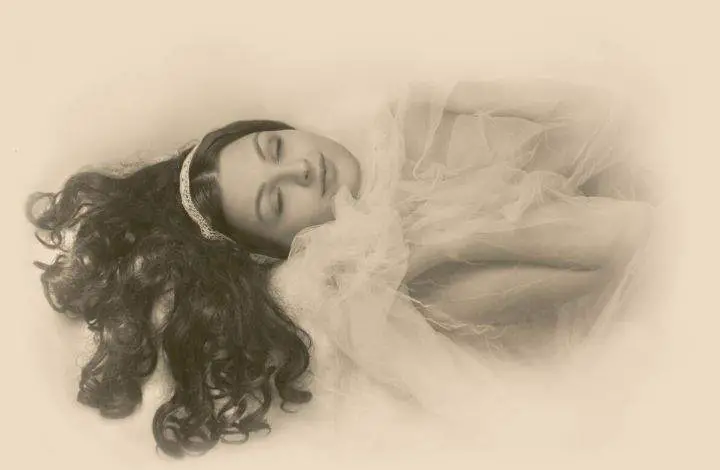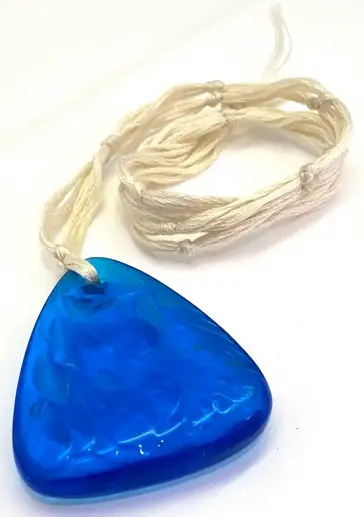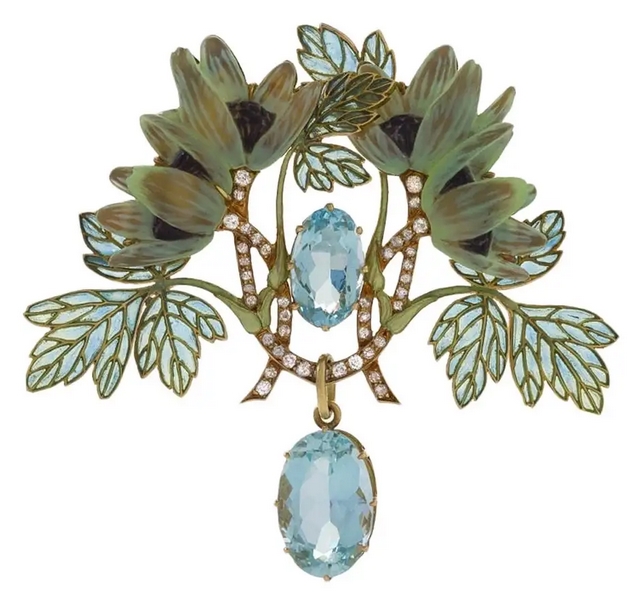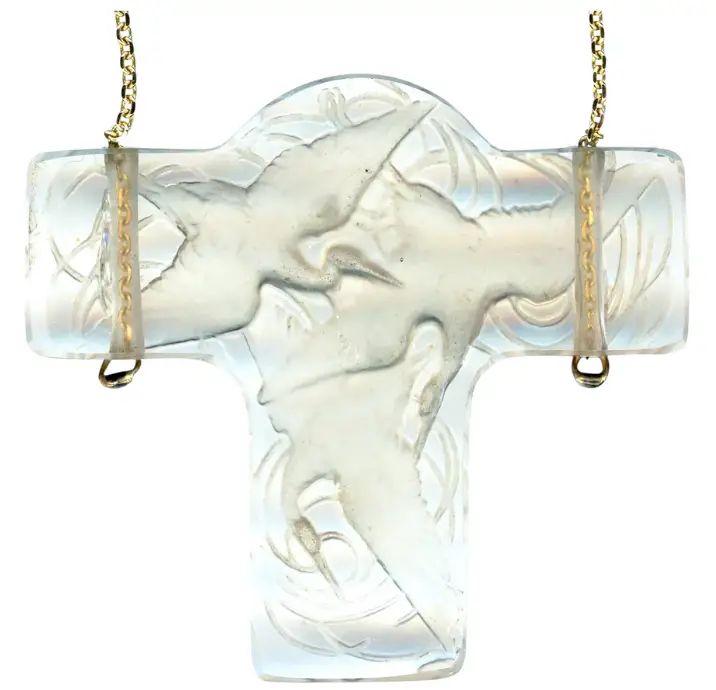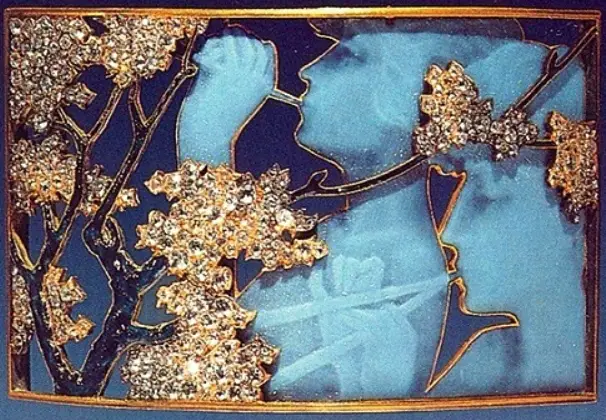Hey There! We may earn a commission from links on this page. This helps support the site and is at no extra cost to you. Thanks!
Rene Lalique introduced new techniques and new materials to the art of jewelry design. He has been considered the creator of modern jewelry from the beginning of the 20th century. If you are looking to add some vintage Rene Lalique jewelry to your collection, you have come to the right place. Here you will learn about the history, jewelry marks, materials used, most collectible pieces, and tips on how to buy.
Brief History of Rene Lalique Jewelry
René Lalique was born in 1860 in Ay, a rural commune-type village in France. While still young, he moved with his family to the Paris suburbs, but he never lost touch with his love of the countryside and fascination with the things of nature. Many of his jewelry pieces were influenced by the flora and fauna he experienced in Ay.
He studied botany as a child and drew plants and insects. Later, he honed his drawing skills at the School of Decorative Arts in Paris. He was apprenticed to goldsmith Louis Aucoc, a leading Parisian Art Nouveau jeweler, until he went to London to attend the Crystal Palace School of Art. When he returned to Paris, he worked freelance, designing jewelry for prestigious houses such as Cartier and Boucheron.
In 1885, he opened his own shop and designed his first parures (sets of matching jewelry, e.g., necklace, earrings, brooch) in gold, contributing significantly to the Art Nouveau movement. At a time when traditional designs fashioned in gold and diamonds were popular, his designs of dragonflies, peacocks, snakes, and sensuous women were rendered in such innovative materials as horn, mother-of-pearl and glass.
See examples of Rene's work:
At the 1900 Paris Exposition (world's fair), crowds flocked to Rene's display of Art Nouveau brooches and combs, and soon he was internationally known and instrumental in spreading the Art Nouveau movement throughout Europe and across the sea to the United States. His work exemplified modernity and elegance at the height of La Belle Époque, the “Beautiful Age” in France. Fellow jewelers admired him, and royalty, socialites, the wealthy from around the world wanted to be adorned in his exquisite jewelry. Among his patrons was the renowned French actress Sarah Bernhardt, the first international stage star and one of the best-known figures in the history of the theater. Today, Elton John and Barbra Streisand are among the serious collectors of Rene's work. They have been spotted at Lalique auctions.
In 1905, Rene moved his shop to the Place Vendôme, a square that was one of the most prestigious places in Paris and the site of the finest jewelry houses and French high-fashion houses. There, he displayed his glass objets d'art along with his jewelry. Famed perfumer Francois Coty's shop was nearby, and Coty commissioned Rene to create singular, magnificent bottles for his perfumes. Rene continued creating perfume bottles for Coty and other famed perfumers—at least 400 bottles are known, but countless others are presumed. Click on Lalique perfume bottles to see fabulous examples.
Watch to see Rene Lalique's perfume bottles:
During the 1920s and 1930s, Rene was one of the world's most revered glassmakers. He no longer worked in gold, but continued to create jewelry in glass.
Rene died in 1945. His son, Marc, took charge of the company and brought Lalique into the age of crystal. In 1977, Marc died and his daughter, Marie-Claude, became CEO and returned the company to designing jewelry and ventured into producing fragrances. Marie-Claude died in 2003. In 2008, the company was bought by the Swiss group, Art & Fragrance. Today, Lalique produces luxury items: jewelry, decorative home accessories, perfumes, and art.
In 2011, the Lalique Museum opened in Wingen-sur-Moder in northeastern France. The museum houses more than 650 pieces by René's and his successors' collections of jewelry, glass and crystal.
Jewelry Marks
- Prior to 1930, “France” did not appear on any piece. It was then that the United States ruled that imported goods display the country of origin, and the US was the largest import market in the world. The pieces that do not show “France,” therefore, include Rene's finest works.
- Before 1945, “R. LALIQUE, FRANCE”
- After 1945, the “R” was removed: “LALIQUE, FRANCE”
- “R. LALIQUE”
- “R LALIQUE” (without period after the R)
- “LALIQUE”
- “R.L.”
- “R L” separated by a cross-shaped symbol in a diamond shape.
Note: Rene did not personally sign most of the jewelry.



Materials Used
Noteworthy Collectibles of Vintage Rene Lalique Jewelry
Electric Blue Fruits Pendant
The pendant was made in 1920 by Rene with molded electric blue glass with a silk cord.
Brooch with Aquamarine, Diamond and Plique-à-Jour Enamel
Rene created this Art Nouveau brooch in 1897, prior to his celebrated appearance at the 1900 Paris Exhibition. It is fashioned from 18K gold and plique-à-jour enamel with two oval aquamarine stones and leaf stems lined with small round diamonds.
Crystal Cigognes Pendant - Three Swirling Cranes on 14K Gold Chain
In 1919, Rene designed this crystal pendant with three cranes dancing in a swirl of wings. It measures approximately 2 inches by 1 ¾ inches.
Art Deco Glass “Deux Faisans” (“Two Pheasants”) Brooch
Made in the 1920s with clear and frosted glass and a silver-colored foil backing, the two delicately carved pheasants are intertwined on a unique brooch, which measures 3.5” by 1.25” (9cm by 3cm).
“Dog Collar” Plaque in Gold, Diamonds and Enamel
“Dog collars,” wide necklaces that fit closely about the neck, have been in fashion and out of fashion. At the end of the 19th century - beginning of the 20th century, they were iconic pieces of jewelry. This Japanese-inspired plaque depicts two revelers in a diamond-encrusted woods.
Tips for Buying Vintage Rene Lalique Jewelry
Rene's works are well documented, so it is not difficult to become educated enough to be fooled by forgeries. Carefully study the books, magazine articles, sale catalogs and other reference materials available at Lalique Books and Library.
Contact “Rene Lalique Consulting Services” for authentication. They will not charge for a reasonable number of pieces requested by the owner only. If you are considering buying a piece, contact them for a consulting fee quote.
Most forgeries have engraved and etched hallmarks made with rubber stamps and acid. Others are made with stencils and sandblasting. Hallmarks are also cast in the mold, either raised or incised. The bottom line is that you must depend on more than the hallmark to determine age and authenticity.
A guaranteed sign of forgery is a piece signed “Rene Lalique.” “Rene” was never used at any time.
A hallmark with a single “R” will add hundreds of dollars, maybe thousands, to the price.
Conclusion
Visit Rene Lalique Jewelry pages on Etsy and Lalique Jewelry on eBay. While browsing there or any online site, be sure to distinguish between the “Lalique-inspired” and “Lalique style” pieces and the genuine articles.

